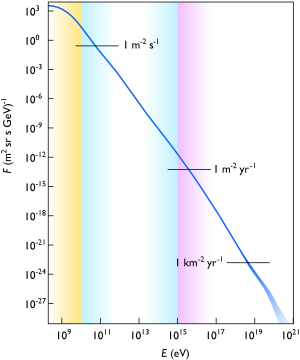Space Radiation: Difference between revisions
| Line 13: | Line 13: | ||
High energy massive particles, such as these cosmic rays, will have a high [[Particle_Accelerators#Magnetic_fields|gyroradius]], so they will not be strongly deflected by magnetic fields. Consequently, more energetic cosmic rays can pierce a planets magnetosphere to deliver radiation dose to those in orbit. | High energy massive particles, such as these cosmic rays, will have a high [[Particle_Accelerators#Magnetic_fields|gyroradius]], so they will not be strongly deflected by magnetic fields. Consequently, more energetic cosmic rays can pierce a planets magnetosphere to deliver radiation dose to those in orbit. | ||
Cosmic rays come through at a steady sleet, delivering on the order of | Cosmic rays come through at a steady sleet, delivering on the order of 1 – 2.5 mSv/day<ref name="CRaTER update">https://agupubs.onlinelibrary.wiley.com/doi/full/10.1002/2015SW001175 Mazur, J. E., C. Zeitlin, N. Schwadron, M. D. Looper, L. W. Townsend, J. B. Blake, and H. Spence (2015), "Update on Radiation Dose From Galactic and Solar Protons at the Moon Using the LRO/CRaTER Microdosimeter", Space Weather, 13, 363–364, doi:10.1002/2015SW001175. The values given here are corrected for the roughly <math>2 \pi</math> steradian shielding afforded by the moon and modified for relative biological effectiveness.</ref><ref name="Cucinotta">[https://ntrs.nasa.gov/api/citations/20070010704/downloads/20070010704.pdf Francis A. Cucinotta, "Space Radiation Organ Doses for Astronauts on Past and Future Missions"]</ref>. This dose is not delivered fast enough to cause acute radiation sickness, but is roughly two orders of magnitude higher than the natural background radiation dose on Earth. This can cause issues with chronic radiation exposure. The main concern is an increased risk of cancer. However, experiments on rodents exposed to radiation from a particle beam simulating long duration exposure to cosmic radiation also suggests the possibility of reduced cognitive function after several months in deep space<ref name="cognitive dysfunction">https://www.nature.com/articles/srep34774 Vipan K. Parihar, Barrett D. Allen, Chongshan Caressi, Stephanie Kwok, Esther Chu, Katherine K. Tran, Nicole N. Chmielewski, Erich Giedzinski, Munjal M. Acharya, Richard A. Britten, Janet E. Baulch, and Charles L. Limoli, "Cosmic radiation exposure and persistent cognitive dysfunction", <i>Scientific Reports</i> <b>6</b>, 34774 (2016). https://doi.org/10.1038/srep34774</ref>. The cosmic ray dose rate is lower in times of high solar activity as the increased solar wind prevents more cosmic rays from entering our solar system. A planetary magnetosphere like that of Earth can deflect enough of the lower energy cosmic rays to make a noticeable difference in the dose rate<ref name="Cucinotta"></ref>, often in the 0.2 – 1 mSv/day range, although this depends strongly on the latitudes through which the satellite passes. A significant amount of this shielding is also afforded by the planet itself, which will block cosmic rays from close to half the sky for close orbits. | ||
Cosmic rays passing through a computer chip can cause transient errors that can result in a glitch in operations or a corrupted bit of memory. | Cosmic rays passing through a computer chip can cause transient errors that can result in a glitch in operations or a corrupted bit of memory. | ||
Revision as of 11:40, 18 February 2024
Space is trying to kill you. It tries to kill you in many different ways. One of those ways is to flood itself with dangerous radiation that can kill biological organisms, damage or disable electronics, and degrade some kinds of materials.
Galactic Cosmic Rays

Space is filled with energetic charged particles – primarily protons (~90%) and alpha particles (~9%) but also including other light and medium ions. These are not associated with any immediate stellar environment but instead are thought to come from outside of our solar system, originating in supernovas, neutron stars, active galactic nuclei, quasars, and gamma ray bursts.
These cosmic rays generally have much higher energies than other forms of space radiation. A typical energy common to one of these particles would be around several hundred MeV to a GeV. Some have lower energies; these are often shielded from solar systems or planets by the sun's magnetic field, the solar wind, or planetary magnetospheres[1]. More notorious, however, are those with higher energies. Often much higher. The most energetic cosmic ray ever measured (as of 2024) had an energy of eV, or around 50 joules – the energy of a major league baseball pitch in a single particle[2].
High energy massive particles, such as these cosmic rays, will have a high gyroradius, so they will not be strongly deflected by magnetic fields. Consequently, more energetic cosmic rays can pierce a planets magnetosphere to deliver radiation dose to those in orbit.
Cosmic rays come through at a steady sleet, delivering on the order of 1 – 2.5 mSv/day[3][4]. This dose is not delivered fast enough to cause acute radiation sickness, but is roughly two orders of magnitude higher than the natural background radiation dose on Earth. This can cause issues with chronic radiation exposure. The main concern is an increased risk of cancer. However, experiments on rodents exposed to radiation from a particle beam simulating long duration exposure to cosmic radiation also suggests the possibility of reduced cognitive function after several months in deep space[5]. The cosmic ray dose rate is lower in times of high solar activity as the increased solar wind prevents more cosmic rays from entering our solar system. A planetary magnetosphere like that of Earth can deflect enough of the lower energy cosmic rays to make a noticeable difference in the dose rate[4], often in the 0.2 – 1 mSv/day range, although this depends strongly on the latitudes through which the satellite passes. A significant amount of this shielding is also afforded by the planet itself, which will block cosmic rays from close to half the sky for close orbits.
Cosmic rays passing through a computer chip can cause transient errors that can result in a glitch in operations or a corrupted bit of memory.
Because they can have such a high energy, cosmic rays can be difficult to shield against. On Earth, we have the benefit of ten tons of air over every square meter of ground to help intercept and stop this space radiation. In addition, cosmic rays initially interact with the atmosphere at altitudes of several tens of kilometers[6]. This initiates a hadronic shower, where the cosmic ray directly strikes a nucleus (of oxygen or nitrogen in this case) and delivers enough energy to shatter it, producing nuclear fragments and creating various particles such as pions, kaons, protons, neutrons, electrons and antimatter. These particles are themselves energetic and can produce even more particles by striking the nuclei of other atoms in the air. The great distance that the particles have to travel to reach the ground means that most of them decay before reaching us. One of the decay products, muons, are the primary radiation that affects us on the ground but even muons have their flux significantly attenuated by the distance they must travel to get to us. In addition to hadronic showers, electron-gamma showers are produced when energetic electrons, positrons or gamma rays are created, which in turn produce increasing numbers of electrons, positrons, and gamma rays; but these usually peter out before their radiation reaches the ground.
In space, it is expensive to carry this much shielding. Even worse, a moderate amount of shielding might make things worse, by allowing the impacting cosmic rays to produce more secondary particles. The best shielding uses hydrogen-rich materials with only light elements to limit the secondary radiation. One of the preferred materials is polyethylene, composed of two hydrogens for each carbon atom and naught else[7]. On a planetary or sub-planetary body lacking an atmosphere, native ice or regolith could be used as shielding by piling it over and around any facilities.
Solar Radiation
Solar Ultraviolet Light
Solar Wind
Coronal Mass Ejections
Solar Flares
Flare Stars
Planetary Radiation Belts
Relativistic Travel
Stellar Corpse Environments
White Dwarfs
Neutron Stars
Magnetars
Black Holes
Supernovas
If you are near a supernova, space radiation is probably one of the smaller of your concerns. However, Type II supernovas are notable in being one of the only phenomena known that can produce dangerous levels of neutrino radiation. Neutrinos are normally so penetrating that they go through everything without significant interactions. However, the core collapse of Type II supernovas makes neutrinos in such prodigious quantities that enough of them can interact and cause radiation sickness and death within approximately the distance of the inner solar system[8].
Artificial Radiation Sources
The main focus of this article is on natural sources of radiation. But if you expect to operate in space you will also need to consider common artificial radiation sources. Many spacecraft and other space infrastructure are expected to be powered by fission or fusion reactors, or to use fission or fusion propulsion. All of these will produce copious amounts of nuclear radiation in the form of energetic neutrons, gamma rays, and the emissions of radioactive isotopes produced through fission or neutron capture. Without an atmosphere to attenuate the radiation produced, high power radiation sources can have an effect over a much larger distance than a similar unshielded source on Earth. This will produce a hostile radiation environment that will require large exclusion zones or shielding.
In addition, space conflict scenarios are likely to use particle beam weapons, x-ray or gamma-ray lasers, and nuclear explosives. All of these produce radiation as a primary effect or side effect of their operation.
Nuclear reactors and explosions in the vicinity of a planet with a magnetic field can make artificial radiation belts that persist for days to years (depending on the altitude), and can severely damage electronics operating within or passing through the belt[9][10].
Credit
Author: Luke Campbell
References
- ↑ Rahmanifard, F., de Wet, W. C., Schwadron, N. A., Owens, M. J., Jordan, A. P., Wilson, J. K., et al. (2020). Galactic cosmic radiation in the interplanetary space through a modern secular minimum. Space Weather, 18, e2019SW002428.
- ↑ D. J. Bird et al., "Detection of a Cosmic Ray with Measured Energy Well beyond the Expected Spectral Cutoff due to Cosmic Microwave Radiation", Astrophysical Journal v.441, p.144 (1995)
- ↑ https://agupubs.onlinelibrary.wiley.com/doi/full/10.1002/2015SW001175 Mazur, J. E., C. Zeitlin, N. Schwadron, M. D. Looper, L. W. Townsend, J. B. Blake, and H. Spence (2015), "Update on Radiation Dose From Galactic and Solar Protons at the Moon Using the LRO/CRaTER Microdosimeter", Space Weather, 13, 363–364, doi:10.1002/2015SW001175. The values given here are corrected for the roughly steradian shielding afforded by the moon and modified for relative biological effectiveness.
- ↑ 4.0 4.1 Francis A. Cucinotta, "Space Radiation Organ Doses for Astronauts on Past and Future Missions"
- ↑ https://www.nature.com/articles/srep34774 Vipan K. Parihar, Barrett D. Allen, Chongshan Caressi, Stephanie Kwok, Esther Chu, Katherine K. Tran, Nicole N. Chmielewski, Erich Giedzinski, Munjal M. Acharya, Richard A. Britten, Janet E. Baulch, and Charles L. Limoli, "Cosmic radiation exposure and persistent cognitive dysfunction", Scientific Reports 6, 34774 (2016). https://doi.org/10.1038/srep34774
- ↑ Konrad Bernlöhr, "Cosmic-ray air showers"
- ↑ Jon Rask, Wenonah Vercoutere, Al Krause, and BJ Navarro, National Aeronautics and Space Administration (NASA), "Space Faring: The Radiation Challenge. Module 3: Radiation Countermeasures"
- ↑ R. Munroe, "Lethal Neutrinos", xkcd what if 73 (2013)
- ↑ G. F. Pieper, “The Artificial Radiation Belt”, APL Technical Digest (1962)
- ↑ John C. Ringle, Ludwig Katz, and Don F. Smart, "Electron and Proton Fluxes in the Trapped Radiation Belts Originating From an Orbiting Nuclear Reactor", Air Force Surveys in Geophysics, Report Number AD0608784 (1964)


